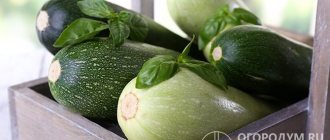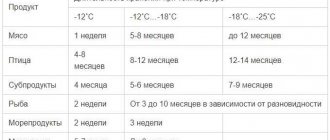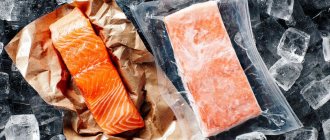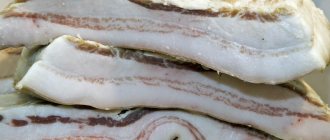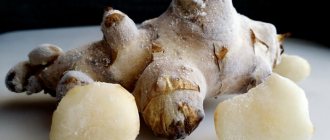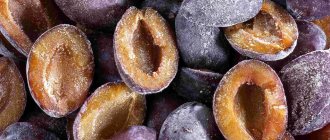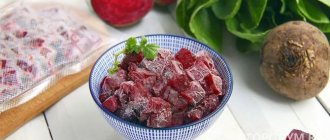If you have room in your freezer, to extend the season for eating fresh zucchini, consider freezing it for the winter. Why?
Summer is the harvesting season, when people try to preserve food grown in their gardens and gardens for the winter. They dry it, make jam, salt it and, of course, freeze it. Moreover, freezing in the presence of a freezer is the fastest way to preserve maximum nutrients.
Zucchini is a healthy vegetable. It is easily digestible, contains few calories, but many minerals and vitamins, among which potassium, magnesium, and B complex vitamins should be highlighted.
Suitable for first feeding for infants. Recommended for those who experience problems with gastrointestinal tract diseases. Useful for the elderly and patients with food allergies.
In winter, frozen vegetables can be used to prepare a variety of dishes, from stews to caviar. Used for making sauces and baking. Fried with herbs. Pancakes and cutlets are being prepared.
General requirements
Kitchen maneuvers should begin with the selection of vegetables. Due to the high water content, it is worth relying on small, not fully ripe specimens. The main thing is that there is no damage. It is not prohibited to freeze larger fruits.
Vegetables of any variety are suitable for freezing. Zucchini has denser flesh, regular ones are softer. But this does not affect the taste of, for example, stew. Zucchini just costs more. That's the whole difference.
Young specimens have thin skin that does not need to be peeled. Mature clean.
Before freezing, wash the fruits thoroughly, dry them and cut off the ends.
Depending on frozen use, you can freeze by cutting:
- Cubes;
- Plates;
- Bars;
- Slices;
- In circles.
Grate or puree in a blender. It is recommended to first place the latter in silicone muffin tins, and after freezing, place them in bags or containers intended for storing food in the freezer.
Young fruits in which seeds have not yet formed are best cut into slices. Dice any zucchini that has seeds, removing the seeds.
Stuffed rolls are prepared from slices lengthwise in winter.
Divide the vegetables prepared for freezing into portions of such a size that you can use the entire portion at once. Thanks to this, nothing will go to waste. Also label each package, noting the date of freezing.
Selection of vegetables and their preparation
Zucchini contains many useful mineral compounds, vitamins, and organic acids. In order for the beneficial properties to be preserved to the maximum when frozen, you need to sort the fruits and select only those that meet the characteristics presented below:
- there should be no damage on the surface of the vegetables;
- the skin is shiny and smooth to the touch;
- Zucchini should be medium in maturity. It is better not to use overripe ones for preparations, they lose their taste;
- The fruits should be firm to the touch.
If you are in doubt whether to use zucchini for the preparation or not, then pierce its skin in one place (somewhere in the middle) with a fork. If the skin is easily pierced and the flesh is soft, then the fruit can be taken. But hard and tough pulp is an indicator of fibrousness, which means the zucchini is not yet ready for harvesting.
If you pierce the skin, the vegetable is no longer suitable for long-term storage, so use it for cooking.
Ideally, the fruit should be picked immediately before harvesting, then it will be as fresh as possible and will lose fewer vitamins after processing. But it doesn’t always work out that way. Gardeners often collect zucchini in a few days, this is acceptable, but remember: the longer the zucchini sits in your home, the faster it will spoil and lose its taste. Over time, the skin loses its elasticity, and the pulp softens too much, which makes the fruit unsuitable for further use. If you put vegetables in a cool place for storage, the skin will most likely become stiff, and such preparation will not last long.
Once you have selected the fruits, prepare them for freezing. The procedure consists of several steps:
- vegetables are often soiled because they lie and ripen right on the ground. Rinse debris and soil off the skin several times with cool water;
- cut off the stalk to the very base; if there is a flower at one end, then cut it off;
- Place the washed zucchini on a dry waffle towel and wipe dry on all sides.
Culinary experts argue: should the seeds be removed from the pulp or can they be frozen directly with them? When harvesting young fruits, the seeds do not have time to form. which means there is no need to remove them. For mature zucchini with thick skin, be sure to remove the middle with the seeds and peel off the skin.
How to freeze zucchini slices
For this method, it is better to buy small zucchini without formed seeds inside. In winter, they are used to prepare stews and caviar. Fried with the addition of herbs and garlic. Used for preparing baby food.
Wash and dry the fruits selected for freezing. Trim the ponytails.
Cut into slices 4-6 mm thick.
Arrange in one layer on a tray or flat plate. Place in the freezer.
When the zucchini freezes, put it into bags.
Small portions can be immediately placed in a single layer in ZIP bags and frozen.
Further use
When you need frozen zucchini, remove the bag from the freezer and place it on a plate on the bottom shelf of the refrigerator. You can leave the vegetables to melt at room temperature, then the process will take a minimum of time, and after an hour you can start cooking. If you are going to stew the stew, you can add frozen pieces to the vegetables. The released water will only add juiciness to the dish. Thawed zucchini is suitable for cooking:
- vegetable side dishes;
- pancakes;
- squash caviar;
- cream soups;
- baby formulas.
If you have prepared zucchini boats or circles, then fill them with any filling you wish (chicken, minced pork or beef), sprinkle cheese on top and place in the oven for a few minutes. You will get delicious fried nests that can be served even without a side dish.
Try making several vegetable preparations in different ways, only then you will understand what suits you best. Each method has its advantages, but the end goal is always the same: the vegetable turns out tasty, aromatic and practically no different from fresh. Believe me, this will come in very handy in winter, reinforce your body with vitamins, and treat yourself to homemade deliciousness. We recommend a delicious recipe for sautéed zucchini that will be simply licking your fingers.
How to freeze zucchini cubes
You can freeze overripe zucchini into cubes. Vegetables frozen in this way are also suitable for preparing many dishes.
Wash and dry the fruits. Remove the seeds from overripe ones by cutting them in half lengthwise.
Cut the fruit into slices about 1 centimeter thick and cut into cubes.
To prevent the cubes from freezing after freezing, place them in a single layer on a tray or flat plate. To freeze.
Then put it into bags and put it in the freezer.
Recipes
There are many different options for preparing zucchini for freezing for later cooking. Here are the most popular ones that housewives often resort to.
For a quick stew
You will need: 2 zucchini, 200 grams each.
Preparation:
- Vegetables are washed, cleared of thick skin, stalks, and flower spots. Next, chop the zucchini. Peel two medium-sized onions, chop finely and fry in oil. As soon as the onion turns golden, add grated carrots and simmer these two ingredients together for a while.
- Four red bell peppers are stewed in a small amount of oil. Then the onions, carrots and red peppers prepared in this way are cooled and combined with the zucchini mass.
- The bag to be filled with this mixture should be flat. Place in the refrigerator.
How to freeze zucchini boats
In winter, zucchini frozen in this way can be stuffed with vegetable or minced meat.
For freezing, choose young fruits. Cut the washed and dried zucchini in half.
Scoop out the core with a spoon.
Wrap each half in cling film. The cling film will prevent the halves from sticking together and will allow you to take the amount needed for cooking.
Place in a bag and place in the freezer.
How to freeze grated zucchini
Young zucchini is grated without peeling. Peel and remove the core of overgrown ones.
Wash and dry the fruits. Grate on a coarse grater.
Sprinkle with salt and leave for a while to release the juice.
Place the mixture in a colander lined with gauze. Squeeze out the liquid.
Place in a container or bag. Place in the freezer.
This preparation is used for preparing pancakes, cutlets, caviar, and baby food.
Blanching method
If you have time and desire, you can freeze zucchini by blanching (remember, green beans were prepared this way too?).
The prepared cubes are immersed in boiling water for a few seconds, then dried and frozen using any method described above.
The peculiarity of this method is that boiling water softens the pulp on the surface of the pieces, and shock freezing creates a crust from the softened pulp, preserving the juice and vitamins inside each piece.
How to use it later
Zucchini frozen after blanching is used in the same way as zucchini frozen without it. It’s very tasty to add a couple of handfuls to red borscht.
What's the best way to freeze zucchini for frying?
The above methods have one drawback - after defrosting they become watery.
Many people probably like to fry the first young zucchini with fresh herbs, garlic and mayonnaise. It is difficult to prepare such a dish from frozen.
To avoid this problem, dehydrofrigation is used. This is nothing more than preliminary drying to remove excess moisture from the fruit. The method is applicable to both vegetables and fruits and berries.
Wash the zucchini and peel the skin if necessary.
Cut into 4-5 ml thick.
Place on the tray of an electric dryer for vegetables and fruits or a baking sheet if drying will take place in the oven.
Dry in an electric dryer at a temperature of 55-65 degrees. Turn on the oven at the same temperature. Dry with the door slightly open for better air circulation.
Cool and put into bags.
Zucchini prepared in this way freezes less and when defrosted has a denser consistency.
In addition to the listed freezing methods, zucchini can be frozen in the form of puree. The puree is used in baking, for example bread, by adding it to the dough after defrosting.
The puree is poured into small plastic containers or muffin tins. Then, when frozen, they are transferred to a bag.
After heat treatment, it is used for feeding babies.
Freezing rules
Freezing zucchini is very easy, even if you have never done this before, don’t worry, everything will work out the first time. Follow important rules:
- cut the zucchini into pieces; the whole fruit cannot be frozen. There are many cutting methods, so choose the one you like best;
- After cutting, squeeze out excess water from the pieces. The pulp contains a lot of juice, so it needs to be removed, otherwise after defrosting the zucchini will be too watery and tasteless, and the pulp will “spread”;
- Place the workpiece only in a clean container with a closing lid or in disposable plastic bags. Food grade plastic containers are suitable. If you put zucchini in bags, be sure to remove any remaining air after packing;
- For effective freezing, set the chamber to the lowest possible temperature (-20 degrees).
If you want to preserve the maximum flavor of zucchini, blanch them in boiling water or steam. This will help increase shelf life, and the taste of blanched pulp will be more delicate than that of raw pulp.
Do I need to blanch?
Cookbooks recommend blanching before freezing. But you can skip this procedure. Firstly, zucchini contains a lot of water. Secondly, with a neutral taste that does not require additional preparation.
Blanching is used for:
- Preservation of color and texture;
- Extending shelf life;
- Removing pathogenic microorganisms.
Blanching zucchini is carried out as follows.
Place the prepared fruits in boiling water for 1-2 minutes.
Then cool quickly in cold water.
Place on a baking sheet lined with a kitchen towel or paper towel. Leave so that excess moisture is absorbed and the zucchini dries.
Pack into bags and put in the freezer.


